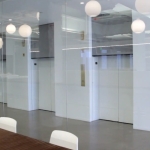Enhance Airport Fire Safety with Fire and Smoke Curtains
Airports are complex facilities that extend far beyond just housing aircraft. In addition to the planes themselves, these hubs contain a diverse array of amenities – from restaurants and boutiques to newsstands and coffee shops. Moreover, airports temporarily accommodate thousands of travelers as they await their flights or retrieve their baggage. This constant flow of people through the various stores and terminals presents a unique fire safety challenge. Rather than protecting a single building type, airport safety personnel must safeguard many interconnected structures. The solution lies in combining compartmentalization techniques with strategic placement of fire and smoke curtains to mitigate the risks posed by the airports’ numerous openings and diverse architecture.
Compartmentalization for Fire Control

Containing the fire during the critical window between fire detection and the arrival of firefighters can significantly reduce risks to human health and building damage.
Compartmentalizing buildings by deploying strategic barriers to create more manageable zones is a crucial practice. This is especially vital in airport terminals, where compartmentalization can significantly slow the spread of smoke and contain fires until help arrives.
Fire and smoke curtains are not just effective, they are one of the most effective ways of creating compartments. Their use in airport terminals can significantly slow the spread of smoke and contain fires until help arrives, instilling confidence in their effectiveness.
How Fire and Smoke Curtains Function
Fire and smoke curtains, constructed from heavy-duty, fire-resistant materials, play a crucial role in fire safety. They come in vertical and horizontal designs. Vertical curtains lower from ceiling-mounted housings to the floor, effectively sealing off a room. On the other hand, horizontal curtains are commonly used in atrium spaces to isolate one floor from another.
Smoke and fire curtains come in three main varieties: Dedicated fire curtains primarily contain the fire itself, though they can also block smoke. Dedicated smoke curtains primarily contain smoke but can also block some flames. Hybrid fire and smoke curtains offer a balance, providing protection against fire and smoke, and are listed under UL 1784 and UL 10B.

Elevator curtains are specialized smoke curtains designed for a particular purpose.
Elevators can compromise smoke control and containment efforts. The airflow in elevator shafts creates an updraft that pulls smoke from the fire floor into the elevator and then disperses it to the floors above. This updraft not only fuels the fire but also allows the uncontrolled spread of smoke, damaging equipment and heightening the risk of smoke inhalation for building occupants.
In the past, building codes required a small lobby in front of elevators to allow them to be blocked off in the event of a fire. Today, smoke curtains designed for elevators meet the same safety requirements while offering a more convenient and unobtrusive solution. These smoke curtains are easily installed and remain invisible unless deployed, avoiding disruption to the room’s design.
Fire and Smoke Curtains Incorporated into Airport Designs
The image above depicts a deployed curtain in the Tom Bradley International Terminal at Los Angeles International Airport.
Fire and smoke curtains are a valuable fire safety addition for airports. As passive equipment, they function independently, making them versatile for multiple applications.
Smoke and fire curtains are easy to install without a full remodel. They are noninvasive and roll up to fit discreetly into most existing ceiling designs. Their slim, compact size allows them easily integrated into most ceilings.
These curtains can integrate with existing fire detection and control systems to enable automatic deployment. When a smoke or fire alarm is triggered, the curtains can automatically deploy, allowing you to quickly contain the flames and smoke.



